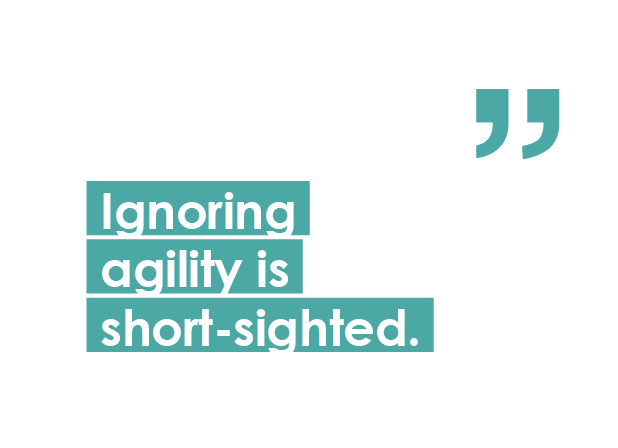Agile transformation is inevitable
A consistently implemented and thoroughly carried out agility program increases work discipline, effectiveness, efficiency and flexibility of individuals, teams and the entire organization. On the other hand, it significantly increases the requirement for high individual as well as common team responsibility. Many people are reluctant and afraid of taking responsibility!
Agile transformation is a huge intervention in corporate culture. That is the reason why HR specialists should be involved in this endeavor. If improperly implemented, it will end up as many New Year’s resolutions to reduce body weight by “healthy” eating and regular exercise. It’s not a new Hollywood “diet that a company can jump in to slim down before they get back to doing business as usual”.
(James S. Wright: Scrum Marketing. 2014, p. 4)
Where to start?
A fish rots from the head down. The decision to implement agility must deny this proverb. Company management has full responsibility for transformation. If the management doesn’t know what to do, just browse the internet. There are myriads of recommendations to evaluate and learn from. The best thing that the management can do is to start transforming the top of the organization in the simplest way: at the individual level. Examples attract. The second-best thing is not to interfere with others, just to support the process and stay informed as the transformation progresses.
Challenges for HR
The first challenge is helping the board gain trust. Without real trust, people will doubt the sincerity of the board’s declarations not to directly intervene, only support the ongoing transformation. Building trust is not a short process. People must learn to forgive a lot, but they rarely forgot anything.
 The second challenge is co-operating with external advisors. If you ask someone to advise you on how to implement agility, pay careful attention not only to what you are told, but also who is telling it. If you are advised by IT experts (former SW developers, Agile coaches, Scrum Masters), review all advice from the perspective of your business.
The second challenge is co-operating with external advisors. If you ask someone to advise you on how to implement agility, pay careful attention not only to what you are told, but also who is telling it. If you are advised by IT experts (former SW developers, Agile coaches, Scrum Masters), review all advice from the perspective of your business.
The third challenge is developing an agile mindset.
The fourth challenge is redesigning the current practice of training and development.
Agile mindset
An agile mindset requires two contradictory states of mind. On the one hand it is creativity, openness towards new ideas, willingness to experiment, out-of-the box thinking, and no fear of failure. On the other hand, it is persistence, gradual improvements, focusing on one issue at a time, and following agreed rules. People belonging to the first group are innovators; those in the second group are adaptors. Only few people can cope with these opposing demands. Both are necessary for a successful transformation but in different periods.
The challenge for HR specialist lies in the proper use of the strengths of the innovators and the adaptors depending on what stage of agile transformation the organization is going through.
Training and development
I would recommend the following changes in the training and development area.
- Implement a culture of asking a giving feedback. Without permanent feedback there is no chance of managing agile transformation successfully. Teams should sit regularly with their leaders and discuss what went well and what could have gone better in their daily business.
- Introduce more individual and small group on-the-job training sessions, mentoring, coaching and reduce the number of classroom training sessions.
- Develop agile leadership. There is no genuine agile leadership! Any leadership can be or needn’t be agile: situational, servant, authentic, tree-color, etc. Agile leadership in a nutshell means that leaders ask three crucial questions: what to start doing, what to stop doing and what to continue doing. Then it’s up to the people to monitor how their leaders follow these recommendations and give them feedback.
- Abandon quarterly performance review and install a modified Scrum inspired ritual of morning stand-ups. Twice a month each team member says what he/she did during the last two weeks and what he/she plans to do in the next two weeks. No evaluation, no assessment, no performance review. Sooner or later everyone will know who performs poorly and who exceeds expectations. And performance review can be done by teams together with managers.
- Train all managers in basic coaching skills: asking more, listening more, talking less and commanding and controlling even less. No specific coaching frameworks are needed to succeed in agile transformation.
Final thoughts
James S. Wright says: “It doesn’t matter so much what kind of organization you are now or how well you perform, but it is important what you become. Whether you are currently first or last in your industry, you can become so much more then you are now. Regardless of the methodology you use to manage your operation; Agile principles will help you become more successful.” (James S. Wright: Scrum Marketing. 2014, p. 28)
Ignoring agility is short-sighted. Approaching its implementation as if it were a New Year’s resolution will end in making the same decisions repeatedly without any apparent effect.
You will achieve the desired effect only if the company management is fully aware that this is not a fashion trend but a necessity which requires adequate conditions for implementation. Only when the management is trustworthy, when you are consistent, persistent and if you learn from mistakes, if you don´t want too much in a short time, if you respect people’s feelings and expectations. And last but not least - if you are an HR specialist, keep in mind that you do not have to rush, but you must not stop.



Follow us